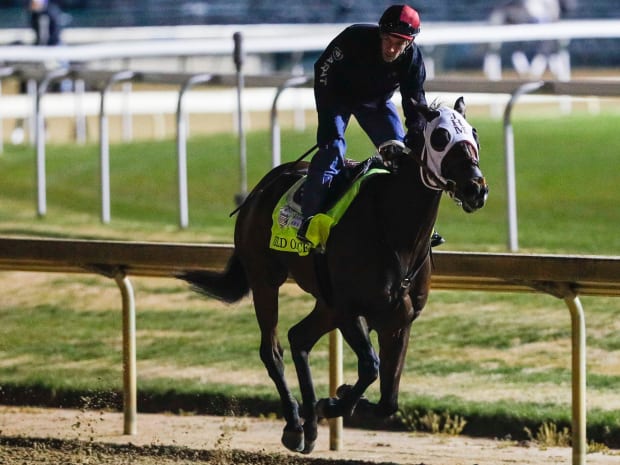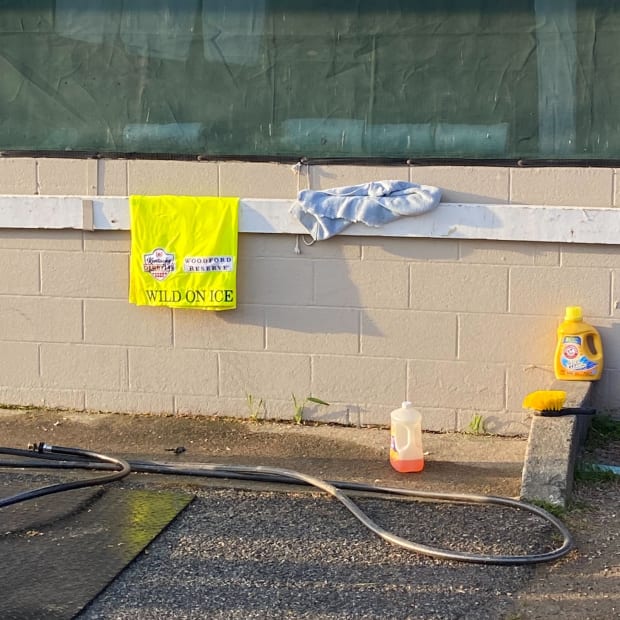By 8 a.m. Thursday morning, all that was left of a Kentucky Derby dream was lying across a wooden railing in front of Barn 43 at Churchill Downs. Folded and placed there like a silent memorial, the bright-yellow saddle cloth read, “Wild On Ice.”
The horse by that name was already gone. Earlier that morning, Wild on Ice had been loaded on an equine van for transport to a surgical facility in Lexington for examination after injuring his left hind leg during his final workout before the Derby, which will be contested May 6. Later Thursday morning came the worst of all updates: The gelding had been euthanized, according to owner Frank Sumpter.
The starkly poignant column written by W.C. Heinz for The New York Sun in 1949, remains revenant: “Death of a Racehorse.” Then, it was Air Lift, son of Bold Venture, full brother to Assault. Today, it is Wild on Ice, son of Tapizar.

Matt Stone/Louisville Courier Journal/USA Today Network
This is the steep price that comes with the sport—injuries are not uncommon for thoroughbred racehorses, some of them fatal. Most of the time they happen when few people are watching. But this is the Kentucky Derby, and even nine days out there are crowds and cameras at Churchill, and the sight of Wild on Ice pulling up in distress was a bad moment for racing.
Wild on Ice’s crestfallen human connections, trainer Joel Marr and jockey Ken Tohill, had quickly departed Churchill for Lexington as well. Their one shot at the biggest race in the United States had disappeared in a tragic eyeblink.
For Marr and Tohill, veterans of the relatively obscure New Mexico racing circuit, the Derby was a moon shot on the verge of happening. Neither had ever gotten a horse this close to the Run for the Roses. And Tohill was here to make history—at age 60, he was set to become the oldest jockey in the 149-year history of the race, the highlight of a 45-year career in the saddle.
Now that’s gone. For the second time, Churchill dealt the tandem a cruel blow in late April.
They’d come here once before, in 2018, for the Kentucky Oaks—the marquee 3-year-old filly race the day before the Derby. Their filly, Blamed, figured to have a real shot that year, having won the Sunland Park Oaks under Tohill that March. But five days before the Oaks, the morning after Blamed’s final workout, a minor injury was detected, and she was scratched from the race.
“That was my Derby, I thought,” Marr told CBS Sports racing analyst Jody Demling last week. “Come all this way, do everything, get right up to it—then it slaps you in the face. That’s how this game is.”
The parallels between what happened to Blamed and what happened to Wild on Ice are eerie. But this time, the slap was harder. The Derby is the Derby, and this injury was much worse. (Blamed went on to race many more times, winning multiple stakes races.)
Wild on Ice’s breakdown brought a sudden end to a determined journey to Louisville. After winning the Sunland Derby at 35–1 odds, Wild on Ice had the Kentucky Derby qualifying points to enter the big race on the first Saturday in May. But Sunland Park was shutting down its training two days after that race, necessitating a long odyssey for the horse.
Marr vanned the horse from the track in the southeastern corner of New Mexico—just across the state line from El Paso, Texas, and not far from the Mexican border—to California. Wild on Ice then was put on a FedEx flight to Memphis, connected to Cincinnati, and from there was vanned the final 100 miles to Churchill Downs.
The horse was going to be a Derby long shot—perhaps the longest in the 20-horse field—but this is a sport for dreamers. Like everyone else in the racing game, Marr watched Rich Strike win the roses at 80–1 for a no-name trainer and jockey just last year. Another long shot, Mine That Bird, had come out of Sunland Park and stunningly won in the Derby at 50–1 in 2009.
So Marr and Tohill and Wild on Ice came to Churchill with a spot in the field and a hope that maybe this was their turn to shock the world. They were stabled in Barn 43, stall 22, and spent the last couple of weeks taking the horse to the track every morning.

Pat Forde/Sports Illustrated
Had they known, they might have felt some misgiving about having Wild on Ice in that stall. That’s precisely where Derby contender Maximum Security was stabled in 2019. That horse won the race, then was disqualified for interference—the first in-race DQ in Derby history.
On Thursday morning at 8 a.m., the only things in the stall were Wild on Ice’s feed tubs, two of them stacked on top of each other. The saddle cloth hung on the railing a few feet away, bathed in soft sunlight. Track business carried on, horses coming and going for their morning exercise.
The primal force of the Kentucky Derby will pull everyone past this jarring moment quickly enough. Most of the prime contenders are scheduled to have their final major workouts Saturday, and then it will be the postposition draw Monday, with Skinner filling the field’s vacancy. Excitement will build throughout the week, and, on May 6, some 150,000 people will come to Churchill for a massive celebration of Americana.
Before then, take a moment to remember Wild on Ice, son of Tapizar, another racehorse felled by fatal injury. The names change, but the story doesn’t.







